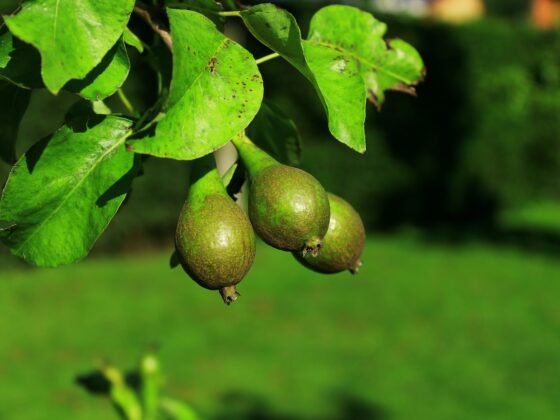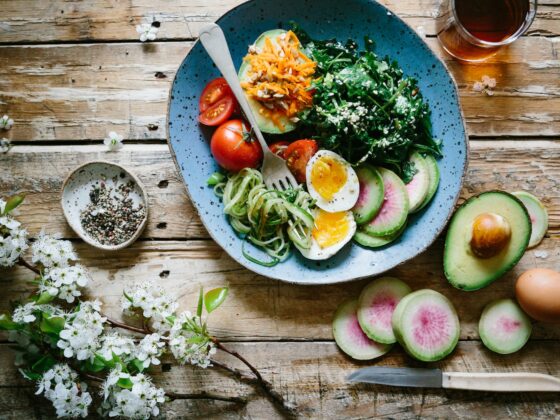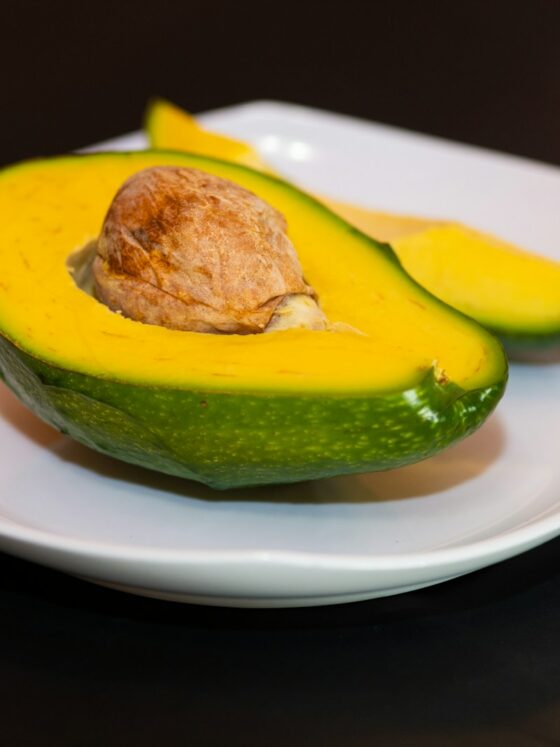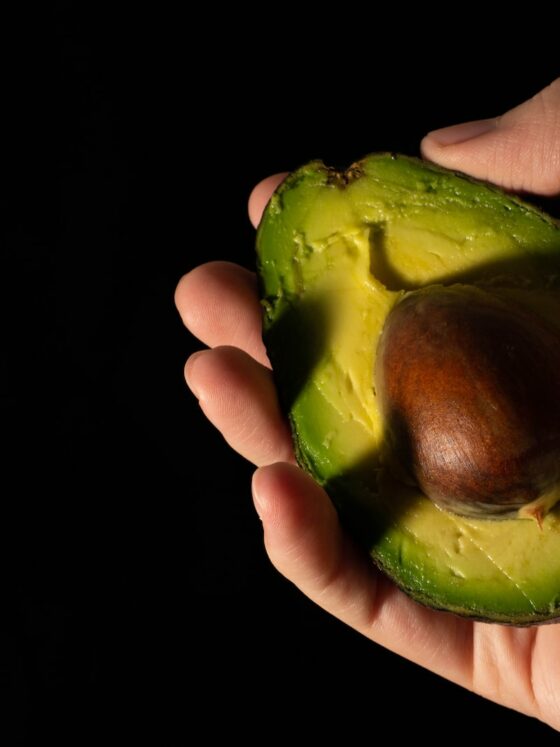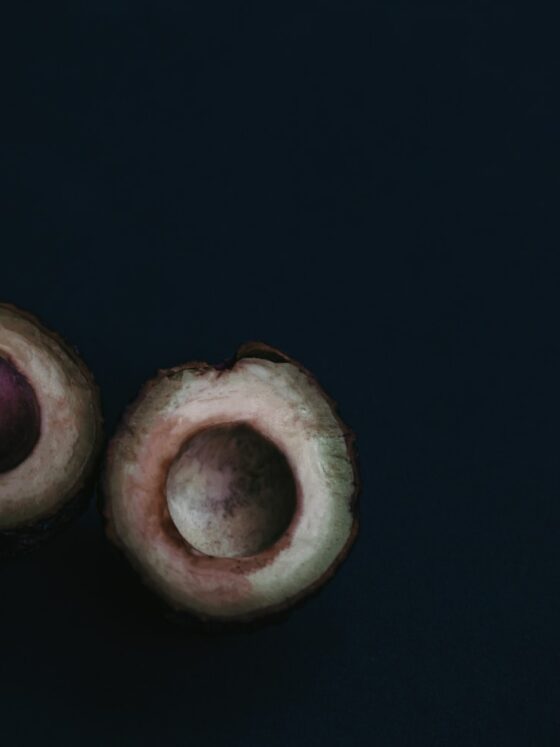Do you often find your avocados going bad before you can enjoy them? Every year, countless avocados are wasted due to improper storage. This article will guide you through the best ways to keep your avocados fresh longer, whether they’re whole or already sliced.
Discover avocado-saving tips and say goodbye to waste!
Table of Contents
How to Determine Avocado Ripeness
To determine if an avocado is ripe, check its firmness and color, perform a stem removal test, or press the skin gently. These methods will help you identify whether the avocado is ready to eat or needs more time to ripen.
Checking firmness and color
Feel the avocado gently with your whole hand; it should yield to firm, gentle pressure but shouldn’t be mushy. A ripe one will feel slightly soft but will still keep its shape. Look at the color too.
Most avocados change from green to a darker brown-green shade when they’re ready to eat. If you see avocados that are very dark or have dents and bruises, they might be too ripe.
The stem can also give clues about ripeness. Try wiggling the small stem at the top of the fruit. If it comes away easily and you find green underneath, your avocado is good to go.
But if it’s hard to remove and you see brown beneath, the inside may be overripe.
Stem removal test
To check the ripeness of an avocado using the stem removal test, gently flick the small stem at the top. If it comes off easily and you see green underneath, it’s ready to eat. A brown color indicates that it’s overripe, while if there’s no color or it’s hard to remove, it needs more time to ripen.
This method helps ensure you pick a perfectly ripe avocado for immediate use.
Remember that checking firmness and color are also good ways to determine whether your avocado is ripe or not. Pressing the skin gently should reveal slight give without feeling mushy.
Pressing the skin
After checking the firmness and color, as well as removing the stem, another way to determine if an avocado is ripe is by gently pressing its skin. A ripe avocado will yield slightly to gentle pressure but still feel firm.
If it feels mushy or too soft, it’s overripe; if it’s hard and doesn’t give at all, then it’s not yet ripe enough. By pressing the skin of an avocado, you can gauge its ripeness without causing any damage.
When storing whole avocados after determining their ripeness using the pressing method, remember that they can be stored at room temperature until they reach your desired level of ripeness.

Best Ways to Store Whole Avocados
Store whole avocados at room temperature until they ripen, then transfer them to the refrigerator to extend their shelf life. You can also use an airtight container or submerge the avocado in cool water to keep it fresh for longer.
Storing at room temperature
To keep your avocados green and ripe, store them at room temperature. Place unripe avocados in a paper bag with an apple or banana to speed up the ripening process. Once ripe, you can leave them on the countertop for 2-3 days before they start to overripen.
Check their firmness every day to ensure they are ready to eat. Remember, once cut, avocados should be refrigerated to keep them fresh for a few days.
By storing avocados at room temperature, you allow them to ripen naturally before enjoying their creamy texture and rich flavor. Avoid refrigerating unripe ones – let nature take its course in bringing out that perfect avocado ripeness!
Refrigeration method
When room temperature storage isn’t suitable, refrigeration is an effective method to keep avocados fresh for a longer time. Ripe avocados can be stored in the refrigerator to slow down the ripening process and extend their shelf life.
Place ripe avocados in the refrigerator to maintain their freshness for a few more days than at room temperature. This method works well when you want to preserve ripe avocados for later use or if you have leftover cut avocado that needs to be stored.
Airtight containers or resealable plastic bags are excellent options for storing ripe avocados in the refrigerator. Make sure they are placed in the coolest part of the fridge, away from other foods with strong odors.
Using an airtight container
To store whole avocados, an airtight container is an excellent option. Simply place the unripe avocado in the container and seal it tightly to prevent air exposure, which slows down ripening.
This method can help extend the shelf life of your avocados and keep them fresh for a longer time. Additionally, it prevents the fruit from absorbing any odors or flavors from other foods in the refrigerator.
When storing cut avocados, remember to use an airtight container as well to keep them from turning brown too quickly. It’s a simple yet effective way to preserve their freshness.
Submerging in cool water
To keep whole avocados fresh for a longer time, you can submerge them in cool water. This slows down the ripening process and helps to maintain their freshness. Ensure the avocados are completely dry before storing.
Now let’s move on to “Storing Cut Avocados”.
Storing Cut Avocados
To keep cut avocados fresh, using lemon juice can help prevent browning, while wrapping them tightly in plastic wrap can also extend their shelf life. Keeping the pit attached to the unused half of the avocado can also help slow down the oxidation process.
Using lemon juice
To keep cut avocados fresh, a simple method is to squeeze lemon juice over the exposed flesh. The acidity of the lemon helps prevent browning and preserves the green color. After applying the lemon juice, wrap the avocado tightly in plastic wrap or store it in an airtight container before placing it in the refrigerator to stay fresh for up to two days.
The use of lemon juice is an effective way to maintain the color and flavor of cut avocados. It’s a natural and easy technique that can help extend the shelf life of your avocados without altering their taste or texture.
Wrapping tightly in plastic wrap
To keep cut avocados fresh for a longer time, another effective method is wrapping them tightly in plastic wrap. This creates an airtight seal around the avocado, preventing air from reaching it and slowing down the oxidation process.
Gently press the plastic wrap directly onto the surface of the cut avocado to ensure it’s in full contact with the flesh, then securely cover the entire avocado. By doing this, you can significantly reduce browning and spoilage, helping to extend its freshness.
Remembering these preservation methods will aid in maintaining ripe avocados ready to eat whenever you desire. With these straightforward tips, your avocados can stay in top condition for much longer periods.
Keeping the pit attached
When storing a cut avocado, leaving the pit attached can help slow down browning. The pit helps to reduce the amount of exposed flesh, which minimizes contact with air and thus slows down oxidation.
This simple method is an easy way to keep your avocados fresher for longer, especially when combined with other storage techniques such as using lemon juice or tightly wrapping the avocado in plastic wrap.
By keeping the pit attached to the cut avocado, you can prevent it from turning brown too quickly and extend its shelf life. This method, along with proper storage, ensures that you can enjoy your avocados over an extended period without worrying about them spoiling.
FAQs on Storing Avocados
Can avocados be frozen?
Yes, you can freeze avocados. Start by cutting the avocado in half and removing the pit. Next, peel the skin off carefully. Sprinkle some lemon or lime juice on the flesh to prevent browning.
Then, place the avocado halves in an airtight container or resealable plastic bag and remove any excess air before sealing it tightly. Label with the date and store in the freezer for up to six months.
Freezing avocados is a great way to preserve them when they are at their peak ripeness, especially if you have an abundance of them. When you’re ready to use them, simply thaw them in the refrigerator overnight or at room temperature for a few hours, and they’ll be ready to enjoy!
How long can cut avocados be stored?
To keep cut avocados fresh, they should be stored in the refrigerator. Cover the avocado tightly with plastic wrap or put it in an airtight container to prevent air exposure and slow down oxidation.
This will help extend the shelf life of the cut avocado for up to two days, keeping it from turning brown and mushy too quickly.
Should ripe and unripe avocados be stored differently?
When it comes to storing avocados, ripe and unripe ones should be stored differently. Ripe avocados should be stored in the refrigerator to slow down the ripening process and extend their shelf life.
On the other hand, unripe avocados should be kept at room temperature until they are ready for consumption. This helps them ripen naturally without becoming over-ripened or spoiling too quickly.
By storing ripe and unripe avocados according to their stage of ripeness, you can ensure that they stay fresh for longer periods, allowing you to enjoy them at their best.
What is the best way to store guacamole?
After learning about storing whole and cut avocados, it’s important to know the best way to store guacamole. The most effective method is to press plastic wrap directly onto the surface of the guacamole in an airtight container before sealing it with a lid.
This prevents air exposure and helps keep it fresh for up to two days in the refrigerator.
Additionally, adding a thin layer of water on top of the guacamole before sealing it can also help prevent browning by creating a barrier from oxygen. These methods will help maintain its freshness and vibrant green color until you’re ready to enjoy it again!
Tips for achieving perfect avocado ripeness.
To enjoy perfect avocado ripeness, follow these helpful tips:
- Look for an avocado that yields slightly to gentle pressure but is not too soft.
- Choose avocados with a dark green color and no visible dents or dark spots.
- For immediate ripening, place the avocado in a paper bag with a banana or apple, which emits ethylene gas to speed up the process.
- Avoid refrigerating unripe avocados as it hinders the ripening process.
- Place unripe avocados in a bowl on the countertop away from direct sunlight to ripen naturally.
- To hasten ripening, you can also place them near other fruits that give off ethylene gas, such as bananas or apples.
Conclusion
In summary, keeping avocados fresh is important to enjoy them at their best. Whether storing whole or cut avocados, using the right methods can help prolong their shelf life. From room temperature storage to using lemon juice for cut avocados, these tips will help you preserve your avocados and reduce waste.
So next time you have ripe or unripe avocados, remember these simple yet effective ways to keep them from spoiling too soon!


